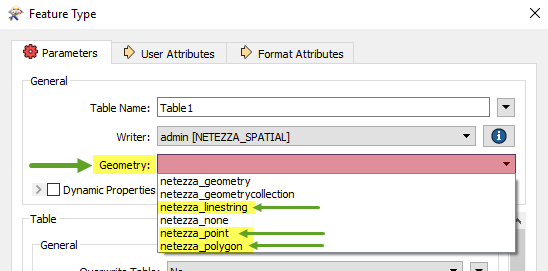To access feature type parameters, click the gear icon  on a feature type in the workspace to open the Feature Type Parameter Editor. To always display the editor in Workbench, you can select View > Windows > Parameter Editor.
on a feature type in the workspace to open the Feature Type Parameter Editor. To always display the editor in Workbench, you can select View > Windows > Parameter Editor.
General
All feature types share similar General parameters, which may include the Feature Type Name, Reader or Writer Name, and Geometry.
In most Writer Feature Type parameter dialogs, you can also control Dynamic Schema Definitions. Some database formats accept a Table Qualifier prefix on the output table feature type.
General
This parameter specifies the type of geometry for features to be written to the destination table.
|
netezza_type |
Database Type(s) |
FME Representation |
|
netezza_none |
Not applicable |
No geometry |
|
netezza_point
|
POINT |
Single point geometry. fme_geometry = fme_point fme_type = fme_point |
|
MULTIPOINT |
Aggregate containing one or more points. fme_geometry = fme_aggregate fme_type = fme_point |
|
|
netezza_line
|
LINESTRING |
Single line geometry. fme_geometry = fme_line fme_type = fme_line |
|
MULTILINESTRING |
An aggregate of linestrings. fme_geometry = fme_aggregate fme_type = fme_line |
|
|
netezza_polygon
|
POLYGON |
A single polygon or donut geometry. fme_geometry = fme_polygon or fme_donut fme_type = fme_polygon |
|
MULTIPOLYGON |
An aggregate of simple polygons or donut polygons. fme_geometry = fme_aggregate fme_type = fme_polygon |
|
| netezza_geometry |
Allows geometries of any of the specific types (points, multipoints, lines, etc.) to be written to the same table. |
|
|
netezza_ |
GEOMETRYCOLLECTION |
An arbitrary collection of geometry. |
When appending to an existing table, if the value of this parameter is incompatible with the geometry column type of the spatial column in the existing table, expect translation failure.
When inserting a geometry, if the type of the geometry is incompatible with the value of this parameter, the translation will fail.
The Format Parameter Write As Multi (see below) modifies this parameter.
Format Parameters tab: Netezza Spatial and Non-Spatial
- No: The table will be created if it does not exist.
- Yes: The table will be dropped if it exists, then created.
- Truncate: If the table does not exist, it will be created. If the table does exist, then all its rows will be deleted.
This parameter instructs the writer to perform Update operations on the table.
The parameter is a comma-separated list of column names (for example, ID,NAME). These column names are used to match the same-named attributes on an input feature against rows in the destination table. Matching rows in the destination table will be updated by the attribute values of the input feature.
Note: If this parameter and Delete Key Columns are both supplied, the translation will fail.
This parameter instructs the writer to perform Delete operations on the table.
The parameter is a comma-separated list of column names (for example, ID,NAME). These column names are used to match the same-named attributes on an input feature against rows in the destination table. Matching rows in the destination table will be deleted.
Note: If this parameter and Update Key Columns are both supplied, the translation will fail.
Format Parameters tab: Additional Parameters for Netezza Spatial
This parameter can be used to specify the name of a spatial column. If it is not specified, the default name of THE_GEOM will be used.
This parameter is in effect only when creating a new table.
This parameter is a modifier for the Geometry parameter (in the Feature Type dialog) when its value is one of netezza_point, netezza_polygon, or netezza_linestring.

This parameter can cause these Geometry values to be treated as MULTIPOINT, MULTILINESTRING, and MULTIPOLYGON, respectively.
In the table below, the behavior of this parameter is described in the context of Geometry = netezza_point.
| Yes |
All incoming points will be written out as MULTIPOINT geometries. All single-level point collections will be written out as MULTIPOINT geometries. All nested point collections will be written out as GEOMETRYCOLLECTIONs. |
| No |
All incoming points will be written out as POINT geometries. All incoming collections of points, including nested point collections, will be flattened and written out, one row per point. |
| FIRST_FEATURE |
The first input feature determines whether this parameter is set to Yes or No:
|
Geometry type mismatches result in translation failure. See Geometry above for details.
Note: This parameter is ignored if Geometry is set to netezza_geometry.
Specifies a fixed width for the spatial column.
Any feature whose geometry is larger than this size will be dropped. If this parameter is not specified, then on insertion, the spatial column width will be automatically expanded in size, as needed, up to the maximum size of 64000 bytes.